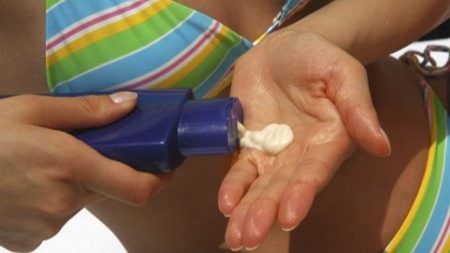August 5, 2018 – Since my earliest years I have had it drummed into me that I must apply sunscreen when headed outdoors whether the backyard, the pool, or the beach. When I was younger my parents warned me about getting a sunburn of which I got many. Then scientists discovered the damage aerosol chemicals were doing to the ozone layer causing an increase in skin cancer. Today when I pay an annual visit to my dermatologist he points out all the sun damage my skin has endured over a lifetime. So I have got religion when outside. I wear a hat. And when my wife and I travel south unless I am swimming I am not in direct sunlight. On our southern vacations to the Caribbean and Costa Rica, I sit in the shade, wear a t-shirt and apply sunblock to any exposed skin.
But now I’m learning that not all sunblocks are equal. Those containing oxybenzone or octinoxate, two chemicals that are effective ultraviolet rays blockers, are proving to be dangerous to marine life, in particular, coral reefs. And if they are dangerous to other forms of life, could they not also be dangerous to the humans applying them to their skin?
Back in 2015, a study appeared in the journal Environmental Contamination Toxicology, describing the toxicological impact of chemicals in sunscreen. It described oxybenzone as a contaminant that is a genotoxicant to corals. In other words, it disrupts their DNA causing abnormal coral reef growth and bleaching. In mouse studies, the chemical causes reproductive changes, reduced body weight, unexplained mortality, and compromised immune systems. And what it does to fish is reduced egg production and hatching, as well as gender shifts in adult populations. It is equally disruptive to insect populations affecting reproductive processes.
That study appeared in 2015, So how come we are hearing about it now in the public airwaves some three years later? And why according to a CNN report are these chemical components in sunscreens going to be banned by 2021 in Hawaii, and who knows where else by what date?
This chemistry that we have been applying to our skin to save us from sun-induced cancer is unsafe for marine life, unsafe for mice, unsafe for fish, unsafe for insects, but not unsafe for us?
The U.S. Food and Drug Administration lists both oxybenzone and octinoxate as approved ingredients in sunscreens. And the American Academy of Dermatology describes the toxicity of these ingredients as not yet proven. I understand that one study published in 2015 might be considered insufficient evidence. But there have been a number of studies (just do a Google search using the phrase “sunscreens environmental toxicity studies”) going back to the early 2000s stating similar results and concerns about the potential toxicological impact of chemicals in sunscreens.
Hawaii has been treating the chemistry of sunscreens as a local concern encouraging users to buy “reef-safe” sunscreens. In Florida, scuba divers are being told not to use oxybenzone containing sunscreens when diving to protect offshore reefs.
Oxybenzone and octinoxate have been detected in seawater around the planet. Oxybenzone has a half-life of 2.4 years. So if you are applying sunscreen containing it whether away from the ocean or at the beach, runoff from showering can eventually find its way to the ocean.
The CNN report states that sunscreens with zinc oxide or titanium dioxide are not harmful to the environment and are effective ultraviolet rays blockers. Unfortunately, the majority of sunscreens commercially available contain oxybenzone and octinoxate. If you don’t see the ingredients in the content they can appear under two other names: benzophenone-3 and octyl methoxycinnamate.
A quick look at two popular brands of sunscreens my wife and I have used was edifying. For example, two of the Neutrogena products we have on our shelves contain oxybenzone and octinoxate. An Aveeno brand we have also used doesn’t but we didn’t like its consistency. We have a Vichy brand that contains none of the chemicals so we are going to look for it on the shelves.
If you too are seeking information about brands free of these chemicals you can go to your local drugstore and check out labels or try and find the information online (the latter a bit tougher).
A blog site I came across authored by Emily Rogan evaluates sunscreens from a medical risk perspective. It is worth a read for practical advice on sunscreen “do’s and don’t’s.”
A last word. Dermatologists qualify studies like the one I described in this posting, stating that we would have to apply the named chemicals daily for years to reach the levels of exposure in the mouse studies. So consider that but also ask yourself how the dermatologists would then describe the exposure levels in the wild indicated by damage from these chemicals to corals?









